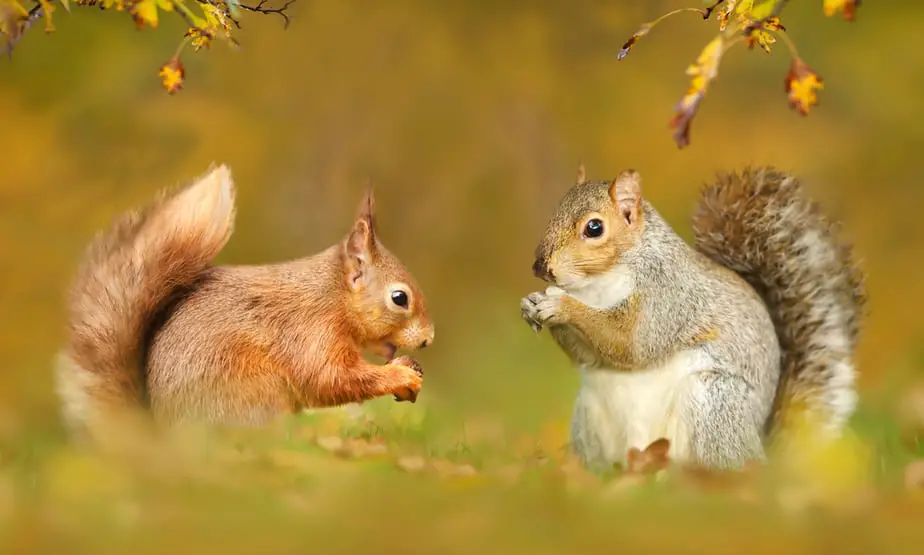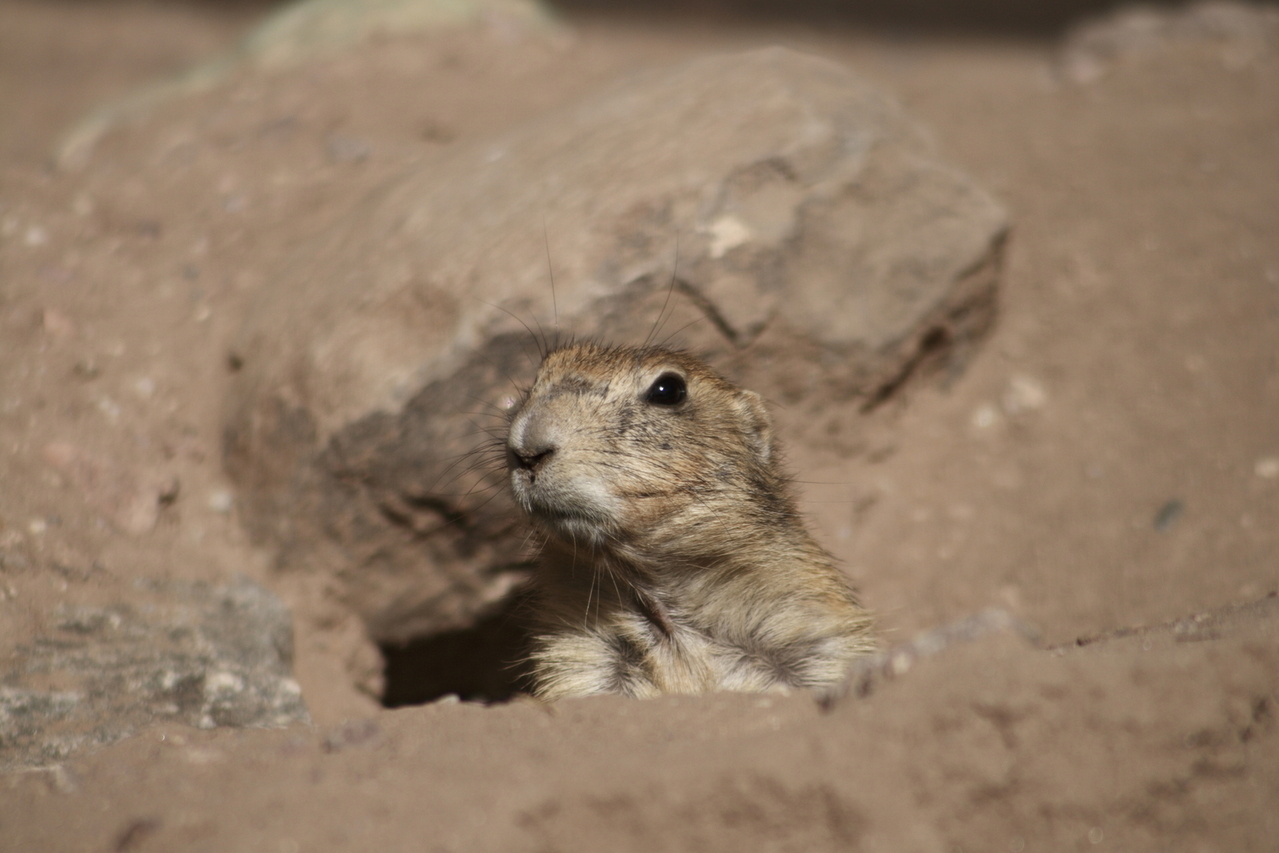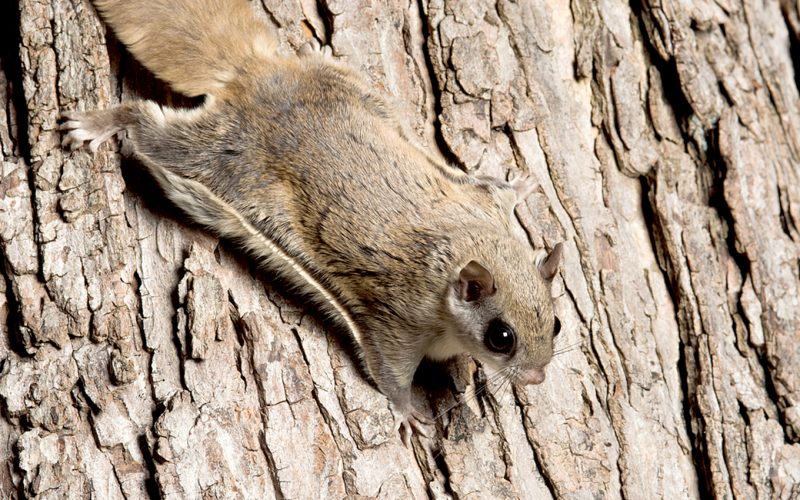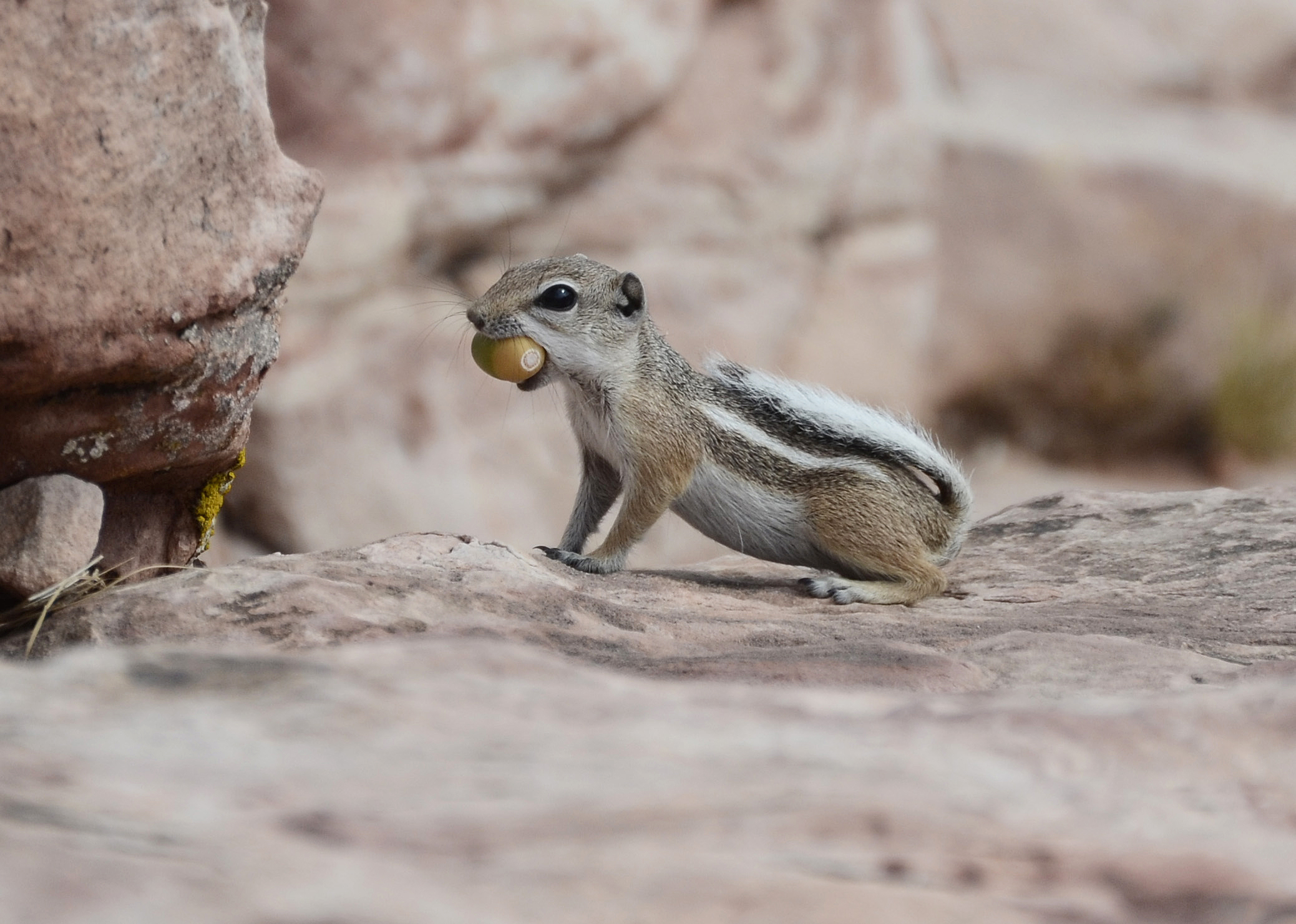Squirrels are common little backyard critters that most of us generally don’t pay much attention to. Though at first glance, squirrels may seem like uninteresting creatures, they actually come in an interesting variety of colors, sizes, and features that are intriguing to consider. Like all kinds of animals, squirrels differ pretty widely in what they eat, how they look, and even how and where they live.

In this article, we’ll be taking a look at the most common types of squirrels (and a few uncommon squirrels), explaining how you can identify them, and providing you with some mind-boggling facts!
Table of Contents
How Many Types of Squirrels are There?
There are over 200 species of squirrels that call the world’s forests, desserts, and suburbs home and only about 5 of these types of squirrels live in the United States. These many different types of squirrels are generally divided into 6 groups: Ground Squirrels, Flying Squirrels, Fox Squirrels, Antelope Squirrels, Red Squirrels, and Gray Squirrels.
In the next few sections, we’ll be looking at each of these types of squirrels more closely, including identification, and other characteristics.
1. Ground Squirrels

‘Ground squirrels’ is a wide term for a variety of rodents that live in holes in the ground, rather than in holes or nests in trees. These include chipmunks, marmots, the California ground squirrel, and the prairie dog. Ground squirrels are generally found in mountainous or desert areas of the United States, but some ground squirrels, such as chipmunks, can be found in lush forests throughout North America.
Identification
Ground squirrels are generally characterized by their in-ground burrows. You’ll see them popping their heads from out of holes, and with some ground squirrels, such as prairie dogs, you’ll find whole families of ground squirrels in one area, littered with holes. Another identification point of ground squirrels is their flat ears that fit closely to the head, their light fur coloring to blend into the desert terrain or forest floor, and their stumpier bodies compared to other leaner squirrel types.
Diet
Ground squirrels have diets that will change slightly with food availability and seasonal changes, but generally, ground squirrels are herbivorous. In the wild, ground squirrels will eat leafy plants, green grass, wild nuts, and wild fruits. If food is scarce, such as in a desert environment, they will supplement with insects such as grasshoppers and winged bugs.
Ground squirrels that burrow in developed areas can wreak uninvited havoc in vegetable and fruit gardens. Their burrows can cause garden damage, and a family of ground squirrels can destroy a garden in no time.
2. Flying Squirrels

Flying squirrels refers to a group of squirrels that live in nests and holes in trees and have flaps of skin connecting the front and back legs, allowing the squirrels to glide from tree to tree. Flying squirrels consist of 50 species including, Sugar Gliders, the Northern and Southern Flying Squirrel, and the Black Flying Squirrel.
Most flying squirrels are found in South America and other areas around the world. The most common Flying Squirrels in the US are the Northern and Southern Flying Squirrel which span from the forests of Maine to South Texas.
Identification
The most identifiable feature of flying squirrels is the fleshy flaps of skin connecting the front and back legs on either side of the body. Another sheer sign of a flying squirrel is a rodent gliding from tree to tree — regular tree squirrels will jump to another branch, but cannot glide like the smooth movements of a flying squirrel. Flying squirrels also have particularly pinched faces with large eyes, as these squirrels are generally nocturnal.
Diet
In the wild, flying squirrels will consume a diet of edible fungi, including truffles. They will also eat wild fruits, leafy greens, and tree products such as nuts and seeds. If they nest near cultivated areas, flying squirrels will also dine on vegetable gardens, fruit trees, and flower beds. When leafy foods and other resources are low, flying squirrels will snack on insects such as winged bugs and bugs found on the forest floor.
3. Fox Squirrels

The fox squirrel is one of the largest, and one of the most common, types of squirrels found in North America. These squirrels are generally found in Eastern and Central North America but have made their way into part of the West, as well. These squirrels also live up into Canada and down into Mexico.
Identification
The fox squirrel best noted for their size and coloration. These large squirrels can range from 1 foot to over 2 feet long. The sheer size is enough to identify these squirrels, but their coloration is also a key characterization. Fox squirrels are generally red, hence the name. However, they can also come in two-tone shades. These shades include gray with copper or red undersides (as own in the photo above) and black with tan or gold undersides.
Diet
A fox squirrel will typically consume tree nuts, such as acorns, fungi, insects, nuts, budding plants, and flower bulbs. These squirrels will often store acorns in holes in trees or bury them underground to go back to during the winter. Occasionally, when food is scarce, or they just need a boost of protein, Fox Squirrels will climb into birds’ nests and eat an egg or two.
4. Antelope Squirrels

Though technically a Ground Squirrel, Antelope Squirrels are placed in their own category due to their unique features and habitat. These squirrels are mainly found in the desert regions of the United States, including Nevada, New Mexico, and other areas of the South-Western United States. They’re also found in Mexico.
Identification
The similar coloring and white stripe patterns on the back and tail of the Antelope Squirrel are quite similar to the Chipmunk, causing misidentification among most people. One of the best ways to tell an Antelope Squirrel and a Chipmunk apart is by looking at their ears. Chipmunks have erect areas that stick out slightly from the head, while Antelope Squirrels have small ears that are flattened to the head.
Chipmunks are also generally found in foresty areas and are less common in the desert regions of the United States. The area in which you see this type of squirrel will point to either a chipmunk or an Antelope Squirrel. Lastly, Antelope Squirrels have tails that are less bushy than that of a chipmunk, which tends to have bushier tails.
Diet
Antelope Squirrels, like all squirrel types, omnivorous with a mainly herbivorous diet. They will dine on leafy foliage, seeds, wild fruits, insects, and even small lizards and rodents smaller than they are.
5. Red Squirrels

One of the largest species of squirrel, the Red Squirrel has a fiery red coat with a white or cream underside and lives all throughout the United States (excluding areas of the East Coast). These are generally tree squirrels and can be found climbing the trunks of trees, hopping from branch to branch, and making a leaf nest in tree branches, in a tree cavity, or in holes. Occasionally, they will nest in ground burrows.
Identification
Red squirrels are incredibly easy to identify, not only due to their sheer size but also due to their coloration. Red squirrels can range from 1 to 2 feet long, nose to the tip of the tail, and have a bright orange-red coat. Their ears, unlike many squirrel types, have pointy, long tufts of fur protruding from the tips, creating an exaggerated look. They also have very fluffy and wide red tails.
Diet
A Red Squirrel’s diet includes a wide variety of wild fruits, berries, nuts, and seeds. Their favorite seeds are very young, green seeds, especially from trees that produce cones (such as Pine Trees). An interesting fact about Red Squirrels is that they’ve even been known to lap up the sweet sap of trees, especially those that live in the Northern US or into Canada.
6. Gray Squirrels

The Gray or Grey Squirrel species are native to North America, including all throughout the United States (particularly in the Northern-most regions) and throughout Canada. Like with many of the North American Squirrel species, the Gray Squirrel has also been introduced into regions all around the world, including Britain and Ireland, and Italy.
Identification
Gray Squirrels can mainly be identified by their distinct smokey gray coat and white underbellies. These are relatively large squirrels and can range from a little over 9 inches to 1 foot long from head to the base of the tail. Their tails are pretty massive and wide, making these squirrels hard to miss as they walk along a powerline or tree trunk. Unlike the closely related Red Squirrel, the ears of the Gray Squirrel are sleek and erect.
Diet
Gray Squirrels mostly dine on a diet of nuts and seeds, including those from Oak Trees, Walnut Trees, and hickory nuts from Hickory Trees. They will also consume wild fruits and berries, as well as budded flowers and flower bulbs. Occasionally, these squirrels will feast on small frogs, bird eggs, and flying insects. Gray Squirrels are also pretty common backyard visitors, and if available to them, they will consume wheat and corn.
Nutty Squirrel Facts
In this section, we’ll be providing you with some fun squirrel facts that will give you a new appreciation for these fluffy-tailed creatures!
1. Squirrels Replenish Trees Without Even Knowing It!
When a squirrel buries their seeds or acorns, they bury them in multiple areas, and sometimes forget where their stash is! Forgetful squirrels result in more tree seedlings, which is not only good for them but is also good for us and the environment!
2. Their Sizes Range (Very) Widely!
The smallest squirrel species in the world is the African Pygmy Squirrel, weighing 0.77 ounces, with a total body length of a little over 3 inches, on average.
On the opposite end of the spectrum, one of the largest squirrel species in the world is the Giant Black Squirrel. These squirrels weigh in at nearly 4 pounds (big for a squirrel) and have a body length of 1 to 1.5 feet PLUS another foot or two with the tail! … That’s one big rodent.
3. A Squirrel’s Front Teeth Never Stop Growing!
Similar to hamsters, Guinea Pigs, rats, mice, and other rodents, a squirrel’s front teeth never stop growing and will grow up to 6 inches each year. This keeps their teeth healthy with their constant gnawing and chewing on hard nuts, seeds, and wood. Though a squirrel’s teeth constantly grow, they continuously file themselves down to keep them at a small enough size to still fit in the squirrel’s mouth.
4. Some Squirrels are Loners, While Others Hate Isolation!
Many squirrel species, primarily the tree squirrels, will live, hunt, burrow or nest, and hibernate on their own once they reach adulthood. Tree squirrels especially live particularly lonesome lives, except when mating season comes around, and the mother squirrels are stuck with raising their young.
Other species, however, particularly the Ground Squirrels, will colonize whole fields and live together throughout adulthood. These squirrels will raise their young together, take turns watching and alerting for predators, and eat together.
5. Tree Squirrels are Opportunistic Eaters!
One of the things that make tree squirrels so entertaining to watch is that they will eat almost anything they can get their grubby little paws on. This includes bird feeders, crumbs out on the lawn, and even that sandwich you left on the porch while you went back inside to get a drink. Many homeowners will resort to buying squirrel feeders in an attempt to deter these pesky gluttons from shooing the birds away or thieving picnics.
6. Only Some Squirrel Species Hibernate
While all squirrel species will shelter in place during harsh winters, most squirrels will not hibernate and will spend the fall months collecting as many acorns, seeds, and nuts as possible to sustain them until Next Spring. Hibernating squirrels generally consist of those found in the Ground Squirrel Category, such as the Arctic Ground Squirrel.
Final Thoughts
As you can see, there are hundreds of types of squirrels located all throughout the world, and only about 5 of the different types of squirrels can be found in the United States. Squirrels can range widely in size, coloration, features, and habitat, and upon closer inspection, are pretty intriguing creatures! We hope our guide to squirrel types has helped you!